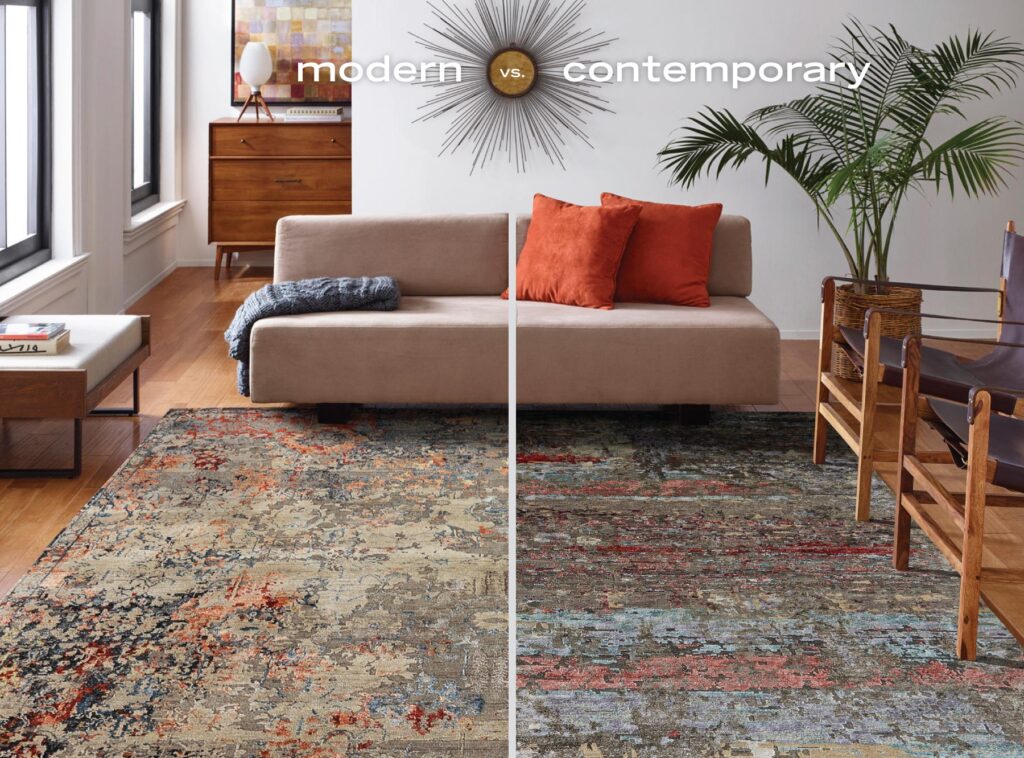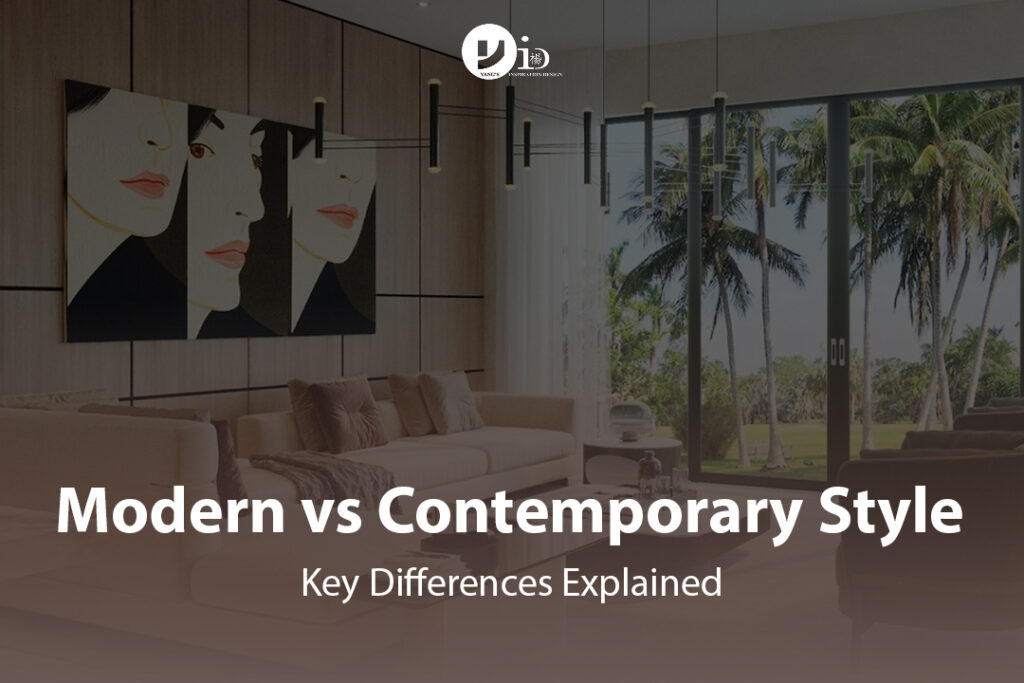It’s one of the most common questions we hear as interior designers: “What’s the real difference between modern and contemporary style?”
The two terms are often used interchangeably, but they represent two distinct—though related—design philosophies. Understanding this difference is the key to defining your personal aesthetic and creating a space that feels truly you.
Modern design refers to a specific, fixed historical period, while contemporary design is a dynamic, fluid style that reflects the “here and now.”
As a leading CaseTrust-accredited design firm in Singapore, we believe in empowering homeowners with clarity. Let’s break down the definitions, key differences, and help you decide which style is the perfect fit for your home.
What is Modern Interior Design? (The Historical Style)
Modern interior design is a fixed design movement that emerged in the early to mid-20th century, roughly from the 1920s to the 1970s. It was a radical rejection of the ornate, cluttered, and heavy styles (like Victorian) that came before it.
This movement was driven by the German Bauhaus school of design, which operated on the powerful philosophy: “form follows function.” This means every single element in a room—from the furniture to the layout—should have a clear purpose and be free of unnecessary ornamentation.
Key Characteristics of Modern Design:
- Philosophy: Function is paramount. “Less is more.”
- Lines: Emphasis on clean, straight, geometric lines. You’ll see strong horizontal and vertical elements with very little fuss.
- Color Palette: Dominated by warm, earthy, and neutral tones. Think whites, beiges, browns, and warm greys. When strong colours are used, they are often primary colours (red, blue, yellow) used as accents.
- Materials: A focus on natural materials like wood (especially teak and walnut), leather, stone, and natural fibres. This is paired with “new” industrial materials of its time, like steel, concrete, and glass.
- Furniture: Pieces are often iconic and timeless (think the Eames Lounge Chair or Barcelona Chair). Furniture is often raised off the floor on slim legs, creating a sense of lightness and space.
Don’t Confuse “Modern” with “Mid-Century Modern” (MCM)
A major source of confusion is Mid-Century Modern (MCM), which is a subset of the broader Modern movement (peaking from the 1940s to 1960s). MCM is the “warmer” version of Modernism, incorporating more organic shapes, pops of colour (like avocado or mustard), and a strong connection to nature. When many people picture “modern,” they are often picturing MCM.
What is Contemporary Interior Design? (The Evolving Style)
In one word, contemporary design means “of the moment.” It is not a fixed historical style; it is a fluid, dynamic, and ever-evolving philosophy that reflects the trends of right now.
What was contemporary in the 1980s (with its bold geometrics and neon) looks entirely different from what is contemporary today (with its focus on “warm minimalism,” sustainability, and smart technology).
Because it’s about the “here and now,” contemporary design is eclectic. It borrows elements from various styles, including Modernism, minimalism, industrial, and even Art Deco.
Key Characteristics of Contemporary Design (Today):
- Philosophy: “Form favors function,” or sometimes, form is the function. This style values comfort, sculptural appeal, and visual impact.
- Lines: While still valuing clean lines, contemporary design prominently features fluid, organic, and sculptural curves.
- Color Palette: Tends toward a stark, high-contrast neutral palette. Think crisp black, bright white, and shades of grey. Bold, trendy colours are used as deliberate, high-impact accents.
- Materials: An eclectic mix that celebrates juxtaposition. You’ll see polished metals (like chrome and nickel), glass, and stone, often mixed with innovative and sustainable materials like recycled composites.
- Furniture: Pieces are often bold, abstract, and sculptural. You’ll see “low-slung” sofas, furniture with soft edges, and “statement” light fixtures that act as art.
Modern vs Contemporary Style: The Head-to-Head Comparison

The easiest way to see the difference is to compare them side-by-side.
- Timeline:
- Modern: Fixed historical period (c. 1920s-1970s). It is “of the past.”
- Contemporary: Fluid and evolving (c. 1970s-Today). It is “of the present.”
- Core Philosophy:
- Modern: Form follows function. A strict, codified ideology.
- Contemporary: Form favors function. A flexible, eclectic approach.
- Color Palette:
- Modern: Warm, earthy neutrals (browns, beiges, warm whites).
- Contemporary: Cool, high-contrast neutrals (black, white, greys).
- Lines & Forms:
- Modern: Strictly geometric and straight lines.
- Contemporary: A mix of clean lines and sculptural, organic curves.
- Materials:
- Modern: Natural materials (wood, leather, stone) and early industrial materials.
- Contemporary: Eclectic mix including innovative, sustainable, and polished materials.
Which Style is Right for Your Singapore Home?
Choosing between modern and contemporary depends entirely on your personality and lifestyle.
You might prefer Modern Design if:
- You value timelessness and history over current trends.
- You are drawn to iconic, functional furniture pieces.
- You prefer a warmer, grounded, and more “natural” feeling space.
- You believe a home should be uncluttered, rational, and serene.
- This style works beautifully in HDBs and condos, creating a calm, cohesive, and non-cluttered environment.
You might prefer Contemporary Design if:
- You are trend-focused and love “what’s new” in design and technology.
- You are more adventurous and drawn to “statement” pieces and sculptural forms.
- You prefer a sleeker, cooler, and high-impact “wow” factor.
- You enjoy a mix of materials and textures.
- This style can make a bold, sophisticated statement, turning any space into a reflection of cutting-edge taste.
Bringing Your Vision to Life with Yang’s Inspiration Design
Whether you’re drawn to the timeless functionality of Modern design or the dynamic, sculptural feel of Contemporary, the key is flawless execution. These styles, especially with their minimalist roots, demand precision—there’s nowhere to hide poor workmanship.
At Yang’s Inspiration Design, we specialise in translating your vision into a meticulously crafted reality. Our vertically integrated model—combining design, project management, and our own in-house carpentry, tiling, and electrical teams—ensures complete quality control from start to finish.
This means we can achieve the seamless, flat-panel cabinetry of a Modern kitchen or the complex, curved feature wall of a Contemporary living room, all to the highest standard.
Start Your Design Journey with Confidence
Feeling inspired to bring clarity and style to your own space? As an RCMA CaseTrust-accredited and HDB Licensed Contractor, we are committed to transparency, quality, and trust.
Contact Yang’s Inspiration Design today for a consultation. Let’s explore your style and create a home you’ll love, all backed by our industry-leading lifetime workmanship warranty.





November 5, 2025
Yang's Inspiration Insight